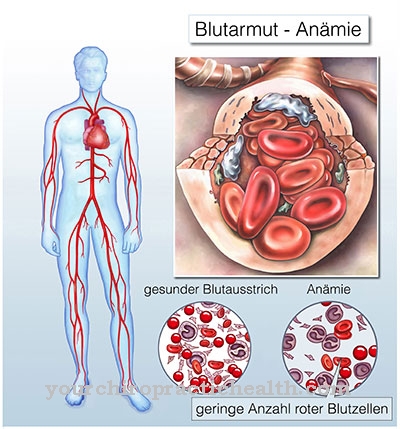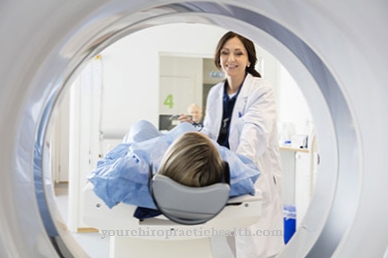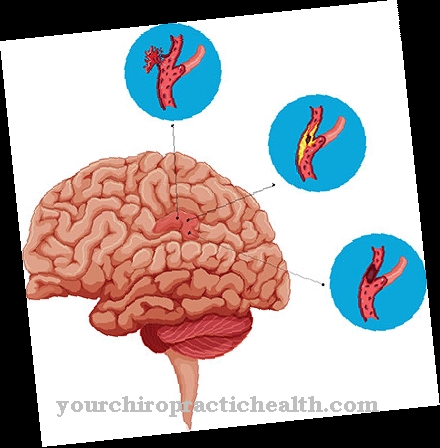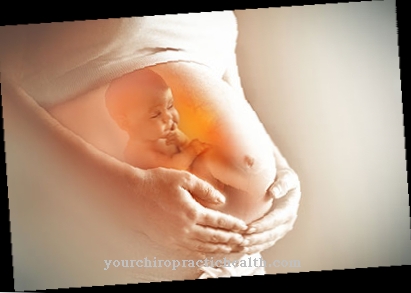The term Paroxysmal hemicrania describes a special form of headache illness. It is characterized by attack-like, unilateral, very violent attacks of pain, which are accompanied by redness on the affected half of the face. The duration of the attacks is a few minutes to in rare cases about 45 minutes.
What is paroxysmal hemicrania?

Paroxysmal hemicrania translates as attack-like, half-sided headache, which already expresses the most important characteristics: Because in this form of headache disorder, being affected from one side is just as characteristic as the relatively short duration of the pain attacks.
The daily frequency ranges from 5 to 40 times per day. Those affected describe the pain that occurs suddenly and suddenly as extremely violent, stabbing, piercing or strongly pulsating. Typically the region of the eye sockets as well as the forehead and temples are mainly involved. Paroxysmal hemicrania also has unavoidable accompanying symptoms in the form of redness and swelling of the eye and conjunctiva, including increased tearing and runny nose-like symptoms.
The rare disease usually appears for the first time between the ages of 30 and 40. Initially, the clinical picture was apparently observed more frequently in women, but more recent research results show that there are no gender-specific differences in terms of the risk of developing paroxysmal hemicrania.
causes
There is no reliable knowledge about the reproducible causes of paroxysmal hemicrania. This is partly due to the fact that this type of headache has only been known as an independent symptomatology and disease for a few decades and is observed more closely as such. Attacking half-sided headache is characterized by a combination of very special symptoms that only a few headache patients have.
In contrast, those affected often report triggering moments that can be observed which precede a pain attack. These include physical strain, stress, alcohol consumption, different foods (e.g. coffee, cheese or chocolate) as well as certain movements in the head area or temperature changes. Recent research has found evidence of a connection between paroxysmal hemicrania and pituitary adenoma and is also examining the role of arterio-venous malformations as a possible origin of the disease.
Since the occurrence of strictly unilateral pain is observed in paroxysmal hemicrania, but the vegetative symptoms (including swelling, redness, lacrimation, etc.) can occur on both sides, an injury to the central nervous system, specifically in the area of the midline, is suspected. Familial accumulation has also been observed.
Symptoms, ailments & signs
Paroxysmal hemicrania is an attack-like headache that is similar in its symptoms to cluster headaches. The stabbing, piercing and pulsating headaches occur on one side. They are mainly located in the area of the eyes, forehead or temples. The patient has at least five headache attacks a day. There are an average of ten attacks.
In extreme cases, up to 40 attacks per day are observed. Each pain attack lasts between 2 and 45 minutes. In contrast to cluster headaches, the pain attacks in paroxysmal hemicrania are shorter. In addition, the number of seizures is greater. During the attack, the patient's need for rest increases, while cluster headaches show unusual restlessness.
The effectiveness of the drug indomethacin is also decisive for the differentiation between paroxysmal hemicrania and cluster headaches. The headache attacks are typically accompanied by other symptoms. These symptoms include conjunctivitis, tears, runny nose, swelling of the nasal mucous membranes, and swelling and drooping of the eyelids.
Overall, women are three times more likely to be affected than men. Two forms of paroxysmal hemicrania can also be distinguished. Usually it is chronic paroxysmal hemicrania. The complaints occur here every day. However, there is still an episodic paroxysmal hemicrania. With this form of the disease, there are pain-free intervals over several weeks and months.
Diagnosis & course
The diagnosis of paroxysmal hemicrania requires an extremely precise anamnesis due to its particularly pronounced symptoms. The clearly one-sided pain attacks are just as characteristic as the need to rest during the attacks.
Not only this last-mentioned factor, but also the sudden occurrence of shorter (between 2 and about 45 minutes) and several times a day attacks differentiates the paroxysmal hemicrania from the similar-looking cluster headache. Furthermore, typical vegetative accompanying symptoms always occur in paroxysmal hemicrania: These include swelling of the eyelids, reddening of the face and conjunctiva, increased tear flow, nasal mucous membrane swelling and drooping of the upper eyelid, with a focus on the affected side.
Different forms of progress are also described: The more common form is chronic paroxysmal hemicrania with mostly daily seizures. In rarer cases, the affected patients are symptom-free for weeks or even months - with this episodic paroxysmal hemicrania, long headache-free intervals can be observed.
The decisive diagnostic criterion is in any case the therapeutic response to the administration of indomethacin - without its effectiveness, the diagnosis “paroxysmal hemicrania” must not be made! Magnetic resonance imaging is also performed during the careful neurological examination, particularly of the pituitary region.
Complications
As a rule, those affected with this disease suffer from very severe headaches. These occur mainly in spurts and can also spread to other regions of the body. In many cases it also leads to earache or toothache. The affected half of the face is usually completely affected by the pain.
The eye can also redden or swell during the pain, so that patients may suffer from visual problems for a short time. The further course of this disease depends very much on the exact cause. For this reason, a general forecast is usually not possible.If the disease is not treated, however, it can also lead to inflammation of the conjunctiva and significantly increased tear flow.
Treatment of this disease depends on the underlying disease. As a rule, however, this is carried out with the help of medication. There are no complications, but a positive outcome cannot always be guaranteed. A healthy and stress-free lifestyle has a very positive effect on the disease.
When should you go to the doctor?
If the characteristic boring headache or any other sign of paroxysmal hemicrania occurs, the doctor should be consulted. The pain attacks increase in intensity and duration relatively quickly and therefore require rapid clarification. If accompanying symptoms such as swelling of the mucous membranes or skin changes occur, a visit to a doctor is recommended. Paroxysmal hemicrania is particularly common in women. The causes can be of a psychological nature, although physical triggers such as chronic pain disorders are also possible.
Anyone who has these risk factors should consult a doctor if the symptoms described occur. Paroxysmal hemicrania is diagnosed and treated by a family doctor or a neurologist. In-patient treatment can also be useful for severe symptoms. First of all, the sick should contact the medical emergency service if there is another headache interval. Since the disease occurs in phases, cause research can be carried out in the painless phases. Close consultation with the responsible doctor is necessary here.
Treatment & Therapy
The first goal in the treatment of paroxysmal hemicrania is to achieve freedom from pain. In order to achieve this, the therapy must be precisely tailored to the respective disease and course form. The drug of choice for paroxysmal hemicrania is indomethacin. In order to relieve the patient of the severe pain symptoms, the average dosage of indomethacin is around 150 mg / day, the range is from 30 to 300 mg per day.
Indomethacin is administered as a long-term therapy; if the pain is successfully eliminated, the daily dose can be gradually reduced in order to find the minimum required maintenance dose. A side effect of treatment with indomethacin is the inhibition of prostaglandin synthesis; effective protection of the gastric mucosa is necessary, e.g. using a proton pump inhibitor. If the administration of indomethacin (maximum approx. 300 mg / day) does not sufficiently relieve the severe symptoms, local anesthesia is also an option.
Alternatively, non-steroidal anti-inflammatory drugs, so-called NSAIDs, can also be administered, e.g. in the form of diclofenac, naproxen or flurbiprofen. In the chronic course of paroxysmal hemicrania, accompanying psychotherapy is always recommended. If triggering factors (e.g. high stress or certain foods) can be observed, avoiding them is also a goal to strive for, because this may be the only causal therapy option for those affected.
You can find your medication here
➔ Medicines for headaches and migrainesOutlook & forecast
Anyone who suffers from paroxysmal hemicrania has to live with headache attacks that occur several times a day. The pain is always one-sided. It is strong and piercing and can also pulsate. Paroxysmal hemicrania is when the person has at least five headache attacks a day. In addition, certain side effects must be present.
The prognosis for such attacks depends in part on careful diagnostic demarcation of the disease from similar attack-like headaches. In addition, it must be determined whether it is chronic or periodically occurring paroxysmal hemicrania. If the diagnosis of paroxysmal hemicrania is unequivocal, the prognosis is usually not very good.
In extreme cases, those affected experience up to 40 attacks per day. You are then in need of rest. A working life is no longer possible. In addition, the condition is chronic in most cases. The length of the seizures varies. They can be very short, but also last three quarters of an hour.
A more favorable prognosis can only be given if the rarely occurring periodic course of paroxysmal hemicrania is present. Here there can be longer pain-free times without headache attacks. Ideally, an affected person can be pain-free for several weeks or even months. It is not yet clear why paroxysmal hemicrania occurs. It is relatively rare.
prevention
Since the exact causes and the development mechanisms of paroxysmal hemicrania are still not clearly understood and known, preventive measures can hardly be recommended. A stress-free and relaxing lifestyle with a good work-life balance may be a preventive measure. However, no reliable preventive behavior can be given for this rare disease at the moment, as the etiology is still largely unclear.
Aftercare
With paroxysmal hemicrania, patients must be particularly careful to refrain from all external influences that can lead to headaches. Affected people should avoid stress and have adequate, well-kept sleep. In phases of strong emotional stress, various therapies are to be used in order to create cognitive relief. Examples are yoga or meditation.
This can help reduce and relieve triggers for stress. Any conflict situations should be avoided by the sick. A great help for aftercare is to increase the quality of life and to strengthen the joy of life. Relaxing leisure activities should be planned and undertaken. For important errands, the help of relatives should be sought. Help is also needed with everyday tasks.
The disease limits those affected, so that social contacts become more important. In particular, relationships with family and relatives should be cultivated so that help can be asked for at any time. The symptoms usually occur more frequently when those affected suffer from emotional stress. Hence, a healthy lifestyle should come first. This means that you avoid any stress, maintain a healthy diet, avoid being overweight and also refrain from consuming nicotine and alcohol.
You can do that yourself
In everyday life, all influences that could trigger a headache must be minimized. Optimal sleep hygiene and adequate sleep are just as important as avoiding stress. In phases of emotional stress, various techniques should be used that provide cognitive relief. Methods of yoga or meditation can help to alleviate and reduce stressors. Conflict situations are to be avoided and should be clarified permanently as quickly as possible.
It is helpful to strengthen the joy of life and improve the quality of life. For many patients this requires a restructuring of the living conditions. In addition, leisure activities should be planned that provide relief. Since the illness is extremely hindering in coping with everyday duties, important errands must be rescheduled in good time. With a stable social environment, the help of relatives or friends can be used. Therefore, social contacts should be cultivated.
In the phases of freedom from symptoms, the person concerned should check carefully which life decisions should be reconsidered. In many patients, the symptoms occur more frequently when they expose themselves to severe emotional stress and compromises. Overall, the person concerned should lead a healthy lifestyle. This includes a balanced diet, avoidance of obesity and adequate exercise. The consumption of nicotine and alcohol is prohibited.












.jpg)



.jpg)










.jpg)
